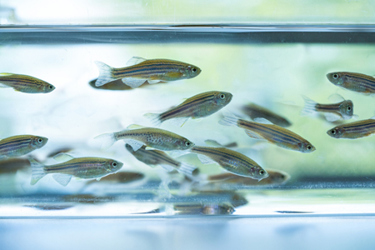Tapping Into Nature's Pharmacy To Develop Safer Antiseizure Medications?
A conversation with Colleen Carpenter-Swanson, Ph.D., University of Richmond

University of Richmond biology professor Colleen Carpenter-Swanson is exploring how a plant-bound compound could pave the way to safe and effective antiseizure medications.
Carpenter-Swanson and her research team recently published an article on the use of zebrafish models to investigate whether vitexin, a natural compound found in various plants, can be used in antiseizure medications.1
In this Q&A, Life Science Connect’s Morgan Kohler caught up with Carpenter-Swanson to discuss her research and the promise of plant-based compounds in drug discovery.
Can you tell us about the untapped potential of plant compounds in drug discovery and preclinical development for treating seizures or other indications?
Plant-derived compounds represent an immense but underexplored resource in drug discovery, especially for neurological disorders like epilepsy. Many of these molecules protect plants from oxidative and inflammatory stress through molecular pathways that also can provide neuroprotective benefits in the human brain.
In my lab, we use zebrafish to quickly assess how plant-derived compounds act in the brain. We showed that vitexin, a flavonoid found in several herbal supplements, can strongly reduce seizure-like activity without disrupting normal behavior or causing harm. These findings add to growing evidence that plant compounds can serve as effective scaffolds for developing new antiseizure therapies.
Despite decades of progress, about one in three people with epilepsy still lack effective treatment options. Incorporating plant-based molecules into early drug screening offers a promising route to discover compounds that act through novel biological pathways. Our findings highlight how nature’s chemical diversity can help accelerate the search for the next generation of safe, affordable, and effective therapies.
What led you to make the decision to test vitexin for seizures?
Vitexin is a flavonoid, which is a plant-based compound known for its antioxidant and anti-inflammatory properties. It is naturally found in plants, such as passion flowers, mung bean, hawthorn, and bamboo.
This is actually a fantastic example of how ideas that sparked in the classroom can grow into meaningful research. My interest in vitexin began with a student-driven project in my upper-level course, Drugs & Genetics, where students identified studies showing that vitexin suppressed seizure activity in rodent models. Intrigued by these findings, I decided to further explore its potential in my own lab. A dedicated group of my research students then assessed the antiseizure effects of vitexin and a panel of structurally related compounds using zebrafish.
Alongside vitexin, we found that isovitexin can reduce seizure activity as well. Our current focus is on identifying even more effective compounds within the same chemical family. We also hope to further confirm their effects in additional preclinical models to determine their potential for human trials.
Why is it important to explore alternative medication options for people who suffer from seizures?
Epilepsy affects about 65 million people worldwide, spanning all ages and backgrounds. While more than 30 FDA-approved antiseizure medications are available, roughly one-third of patients continue to experience seizures despite treatment. In addition, some of these drugs can cause serious side effects, including mood changes, gastrointestinal issues, and bone loss. These challenges highlight the urgent need for new treatment strategies that are both safer and more effective, ultimately improving the quality of life for people living with epilepsy.
Why do you use zebrafish in your research?
Zebrafish are a powerful model for studying neurological disorders like epilepsy because they share many genetic and chemical similarities with humans. Their transparent larvae and rapid development make it possible to see how the brain responds to drugs within just a few days. They also make large-scale testing possible — hundreds of embryos can be studied at once — allowing us to efficiently test many compounds and measure how each one affects various markers of seizure activity.
In our work, zebrafish larvae were exposed to a seizure-inducing compound, and we measured both movement (swimming and hyperactivity) and brain activity before and after treatment with vitexin. We observed a clear reduction in seizure-like movements and abnormal brain activity following vitexin exposure, with no noticeable side effects.
Zebrafish let us test ideas in a whole living system, and growing evidence shows that what works in these tiny fish often predicts results in other mammalian models and, of particular relevance, in humans. This makes zebrafish an invaluable bridge between basic discovery and translational neuroscience.
What is the biggest challenge in preclinical development that you’ve encountered and how have you approached addressing that challenge?
When we think about the costs of drug development, most people immediately think of the high expenses tied to human clinical trials, which are, of course, necessary for bringing new drugs to market. But preclinical work also can be incredibly costly, especially when using more traditional animal models like mice and rats. Given how competitive the grant funding landscape is, exploring models that are more cost-effective yet still predictive of human outcomes has become essential.
For me, zebrafish help to address that challenge. They allow for rapid, economical drug screening and provide valuable early insight into a compound’s clinical potential. They can complement work in mammalian models by helping us narrow down which compounds truly warrant deeper testing. I think there’s real opportunity to improve the drug discovery pipeline by strengthening the steps that come before human trials — and zebrafish are a practical, scientifically rigorous way to do that.
Do you have any advice for drug discovery scientists researching plant-based drugs?
I think it’s important to remember that “natural” doesn’t automatically mean “safe.” Furthermore, I’m a big believer in the saying, “the dose makes the poison,” because even beneficial compounds can become harmful at high enough concentrations. As scientists, we should absolutely tap into the vast chemical libraries that plants offer, but we must also be rigorous in evaluating both efficacy and safety.
It’s an exciting area of research, and I encourage others to explore all that plants have to offer. This work is happening globally. One example close to my heart is the Natural Products Institute at the University of the West Indies in Jamaica. I grew up hearing anecdotal stories about the healing properties of local plants, and it’s inspiring to see modern science testing and validating those claims. From the pain reliever morphine to the anticancer agent Taxol, plants have yielded some of the world’s most effective medicines, underscoring that nature continues to be one of our greatest teachers in drug discovery.
References
- Breckenridge, A., Basnyat, S., Fitch, E., & Carpenter-Swanson, C. (2025). Validating the antiseizure effects of vitexin and related flavone glycosides in zebrafish. Frontiers in Pharmacology, 16.
About The Author
 Colleen Carpenter-Swanson, Ph.D. is a biology professor at the University of Richmond with expertise in genetics and epilepsy. Her research focuses on modeling neurological diseases, such as epilepsy in zebrafish, in hopes of finding new, effective treatments for these disorders. She is also passionate about science communication and education, especially with making science accessible to the general public.
Colleen Carpenter-Swanson, Ph.D. is a biology professor at the University of Richmond with expertise in genetics and epilepsy. Her research focuses on modeling neurological diseases, such as epilepsy in zebrafish, in hopes of finding new, effective treatments for these disorders. She is also passionate about science communication and education, especially with making science accessible to the general public.
She received her BA in Chemistry from Wesleyan University and a Ph.D. in Pharmacology from the University of Michigan. She did her postdoctoral training at the University of California, San Francisco. Carpenter-Swanson is a member of numerous scientific societies, including the American Epilepsy Society and the International Zebrafish Society.
